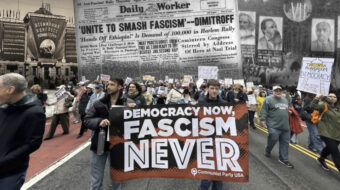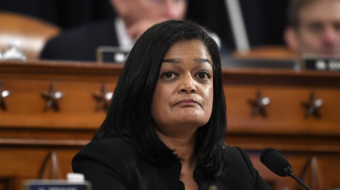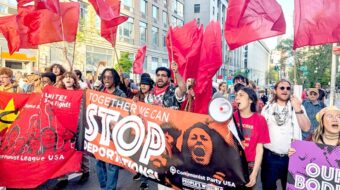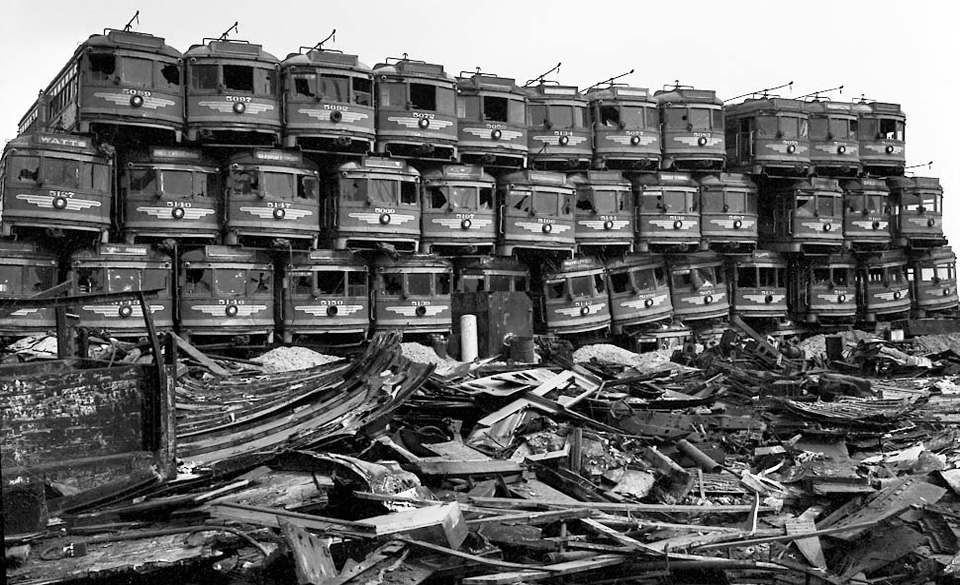
LOS ANGELES — A Communist from L.A. with long family roots in the Party recently shared with me a copy of “A Municipal Program for Los Angeles,” published in April 1959 by the Communist Party of Southern California (so it says right on the cover), and asked me what I thought of it.
Here’s what I think.
First of all, I admire the professional layout and design — with a union printer’s bug, of course! — contemporary and attractive, set out over 15 pages of double columns, and discussing, after an introduction, eight subjects which I’ll summarize below. Page 16 gives the Party’s address in the pre-zip code era as 524 S. Spring St., Rm. 514, Los Angeles 13, California. That address is in the heart of downtown, adjacent to a building (at No. 514) that once served as a bank and now is the Los Angeles Theatre Center. I’ve often passed No. 524 knowing nothing of its history. Did No. 524 have an effective security system, a doorman? What would have prevented violent anti-Communists in that late Eisenhower period from storming into the building, ransacking the office, and perhaps hurting people they might have found there?
The pamphlet confounds my preconception that in the late 1950s, after the McCarthy witch hunts that hit Hollywood rather hard, and equally as important, after the 1956 Khrushchev revelations about Stalin and all the disillusionment that followed, that the Party must have fallen into a deep depressive slump, whoever was still left. Yet here’s this well produced Program obviously intended to let the citizens of L.A. know that the Party was alive and kicking and bursting with all manner of visionary ideas for the future of the city.
I mentioned this impression to my friend who showed me the pamphlet and he recited name after name after name of activists he knew from that period (all unknown to me) who remained in the Party and likely had a hand in the creation of this document. The Program is written as though the Party’s voice was one they felt certain needed to part of the conversation in L.A. as the city expanded in population and influence. It also displays here and there some genuine literary flair.
As other writers and historians have discovered, countering the received wisdom about the Eisenhower era, those supposedly “quiet years” were not so quiet: Currents of protest and resistance can be found throughout American society, in folk music, in poetry and literature, in the civil rights movement, in the beatnik culture, and for sure in the still vital remnant of the formerly more powerful Communist Party.
In presuming to issue a Municipal Program, the Party announces its opposition to capitalism in the Introduction. The Soviet model, with its succession of five-year plans, peers over the shoulders of these writers: “Planning directly for the welfare and flourishing of the people and of their industry and culture — planning by the united people themselves, is the distinguishing characteristic of the socialist system, in contrast with the capitalist system under which we live at present.” We today, 58 years after the release of this publication, have 20/20 hindsight into the formidable problems of socialism, but from the point of view of 1959, European Communists must have felt exuberant pride in the miraculous — no, planned! — recovery only 14 years after the devastation of World War II.
Section I (these are all in classy Roman numerals) treats Unemployment, with some 150,000 unemployed in Metropolitan L.A. (oh, for such numbers today!) “as a result of displacement of labor by automation, speed-up and continued high prices. It is for this reason that support has grown for the demand of a shorter work week.” The Program goes on to ask for federal unemployment “benefits to be paid for the entire period of unemployment.” Automation — robotization — has proceeded apace in the years since, to the extent that Donald Trump’s choice for secretary of labor, Andrew Puzder, envisions replacing his fast-food workforce with automatons which will always upsell his products and won’t need bathroom breaks or sick leave.
Who could talk about L.A. in the 1950s without mentioning Smog, Section II? The Party lays the blame almost exclusively on the auto and oil industries, despite evidence that healthful improvements could easily be made were it not for the lobbyists and corrupt politicians defending the monopolies’ profits. How about this bit of perky writing? “The auto trusts could spend any amount on tail fins and ‘motivational research’ on body curves and styling, but could not consider any advance in the proper business of improving engine combustion until forced to do so by the threat of legislative action.”
The CP proposed, “The auto industry to be compelled to bear the cost of the afterburners. People who bought new or used cars in good faith cannot rightfully now be ordered to pay anywhere up to $150.00 for afterburners which are necessary solely because of the manufacturer’s negligence and disregard for the pubic health.” After the revelations that Volkswagen, and likely other manufacturers, cheated on its smog detection system, and after witnessing generations of resistance to improving gas mileage averages, more than half a century later we know this is still a valid complaint.
“If these and similar points are adopted and enforced, we believe Los Angeles will again be blessed with the crystal clear air that our native sons and daughters remember from their childhood.” In fairness, because of environmental activism imposing stricter regulation, the air quality in L.A. and elsewhere (though not everywhere, of course) has improved dramatically. Such advances are now severely threatened by the new ideology of laissez-faire deregulation.
Housing is a hard-hitting Section III. The Party lambastes segregation of both the Negro and Mexican-American communities, and the super-exploitation of those who overpay in poor neighborhoods because they are disallowed, by restrictive covenants and other real estate scams, to live where they want and can afford. The document condemns federal and other public agencies, banks, insurance companies and landlords in illegal collaboration with such racist practices. A single remarkable paragraph gives a concise précis of the housing crisis from a historical materialist point of view:
“Until the New Deal, the general theory regarding housing had been that it was impossible to build low rent housing, but that as upper classes moved into new expensive housing, the lower classes would move into the vacancies left by them. But even the first World War brought a major move of population into the big cities with which the housing booms were never able to catch up. The depression brought a long gap in construction and a further deterioration of housing, and World War II caused a further congestion of the larger cities. The constant post-war boom in construction has still failed to stop the increase of slums in all major cities.”
The Municipal Program takes a dim view of the Bunker Hill redevelopment in central L.A. which destroyed private housing in an area hungrily eyed by big business interests, and also of the recent eviction of mostly Chicano residents of Chavez Ravine north of downtown to make room for Dodger Stadium. The Party called for integrated, low-rent housing to be made available in both of these modernization projects. The popular Chicano satirical theatre ensemble Culture Clash has focused on this turbulent period in their play Chavez Ravine, opening up to view this buried history and not failing to comment (favorably) on the role of Communists in that struggle.
“The Soviet Sputnik awoke the country to the fact that we are no longer automatically first in the field of science and engineering,” opens Section IV, Education. In terms that evoke all too frighteningly our predicament in the Betsy DeVos era if she is confirmed as secretary of education in Trump’s administration, the Program says: “The McCarthyite war against intelligence and freedom of thought in the schools has paid off with a general backwardness in the educational development of our children and youth, unprecedented in any country claiming a leading position in the world.”
The L.A. Board of Education itself had become a stronghold of anti-communist hysteria. The Party called for modern new facilities, hiring more teachers at adequate wages and “free from the ignominies of loyalty oaths and inquisitions,” and an end to de facto segregation in many L.A. schools, to be rectified “thru facilitating transfer, and if necessary, transportation of minority students to schools outside their areas.” It called for “open apprenticeship training for all skilled jobs” for Negro youth (curiously, Mexican-Americans are not mentioned here) and an end to “the practice of keeping them out of such training on the grounds that they will not be able to get such jobs, while employers and unions explain the absence of Negroes on such jobs by the argument that ‘there are none qualified.’” Note the criticism of racist unions.
Section V: Health. “It is high time that some form of national medical and hospital insurance be adopted by the Federal and State Governments similar to unemployment insurance.” The Program cites issues such as respiratory ailments, fluoridation of drinking water, “the growth of mental disorders under the increasing strain of modern living,” and radioactive clouds drifting over from Nevada H-bomb tests. The CP called “for passage of the Forand Bill for free medical aid to the aged” — a precursor to Medicare that passed under President Johnson six years later. The enormous progress made in American health care in the years since 1959 is on the firing line under the Trump regime.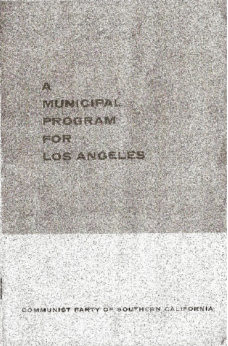
Taxation (Section VI) sets its sights directly on “re-distributing the tax burden more in accordance with ability to pay,” singling out the trusts and monopolies as owing more to the commonweal. Not much change since 1959.
“The idea that city government is merely the administration of city business,” says Section VII, City Government, “was washed up long ago, since administrations based on this idea naturally copied also the morals of Big Business and usually ended up in a welter of graft, corruption and scandal.” The Program cites such recent incidents as “zoning rackets, oil-lease pay-offs, the sub-surface aspects of the Chavez Ravine deal and so on.” The CP raps the city on gerrymandering voting districts to deprive African Americans of City Council representation (again Mexican-Americans are not included in this demand), and urges reform of overlapping city and county functions. In a passage that could have been written yesterday, the Program affirms the following:
“The civil liberties of the people are laid down in the Constitution and its Bill of Rights, but it is in his conduct with the city police that the average citizen finds out whether these guarantees have reality or not. It is far from the meaning of the Constitution and the intent of the Founding Fathers that a man’s civil liberties should be guaranteed only after he has been arrested, beaten up and jailed by the police, bailed and jailed again after a trial in which prosecutor and police form an unholy alliance, and eventually released by a higher court decision that his constitutional rights are violated.”
We need “a police commission that is addicted to the Bill of Rights” and that is willing to charge police officers for disciplinary offenses.
The final Section VIII, City Planning, addresses a number of infrastructural issues around L.A. In a new era that saw the freeways as our principal mode of transportation, the Party called for a serviceable mass transportation system to relieve the smog, traffic congestion and parking crises. Implied, though unstated, is a criticism of the monopoly-instigated tearing up of municipal and intercity trolley and rail lines to make way for the freeways and the car culture, a phenomenon brought out in the 1988 fantasy-comedy film Who Framed Roger Rabbit. It sought a true public ownership of the Metropolitan Transportation Authority, not one that was in hock to municipal bonds and the banks that profit from them. By contrast, the Party had kind words for the Department of Water and Power, truly a jewel of the city, which kept electricity rates low and was still able to invest in future expansion.
The Program envisions an integrated system of rail transportation from suburban cities (much like the one the freeways dismantled) and a futuristic “overhead monorail system” doubtlessly inspired by the recent opening of Disneyland just south in Orange County. It disparaged a subway system as “not practical for such an expanded city,” although in recent decades such an urban Metro nexus has indeed grown to serve its needs.
The following passage bears all the earmarks of some blacklisted screenwriter:
“In the field of its provisions for a rounded cultural life, Los Angeles is still far below the standard required by a major world city. The disdain with which Hollywood and Los Angeles are so often regarded throughout the world is due to the fact that the powerful cultural forces assembled here and the cultural resources of the Southern California people, have so often been overridden by the juvenility, sensationalism and sham of the money moguls who have sought to imprint every film first and foremost with the sign of the dollar. Only in rare cases have the real talents of the writers and actors, and the true possibilities of the motion picture as a medium to interpret life, been allowed to shine through.
“It is high time for Hollywood and Los Angeles to grow up culturally, to leave the tinsel and fairy-tales to Disneyland, the juvenile bang-bang to the juveniles, the advertising hoop-la to Madison Ave.” Predictably, the Program then stirringly calls for an end to the blacklist.
“New cultural facilities are urgently needed in the center of the city.” Perhaps the Bunker Hill redevelopment as articulated in 1959 did not explicitly include this, but in fact, within five or six years that area, only a couple of blocks from City Hall, became the Music Center complex of theatres which continues to anchor cultural life in the city.
A notable and somewhat surprising gap in this otherwise highly prescient document is any reference to the special oppression of women in society.
“Today,” the Municipal Program concludes, in words that have if anything accrued even greater resonance as we enter the post-Obama years, “those who want adequate housing, an adequate transportation system, an end to unfair taxation, a developed community and cultural life, will again have to struggle for these aims against the monopolies. The forces of Labor, in the fight for a better life for the working people, the Negro people in their struggle to end segregation and Jim Crow, the Mexican-Americans in their fight against discrimination — all sections of the people confront the task of uniting their forces into a coalition of the people against the domination of the monopolies, if they are to realize their aims. In every phase of development of the city and city life, only the most determined struggle of such a people’s coalition will decide that things will be done the people’s way instead of the monopolists’ way.”



